Punjab State Board PSEB 10th Class Science Important Questions Chapter 11 The Human Eye and The Colourful World Important Questions and Answers.
PSEB 10th Class Science Important Questions Chapter 11 The Human Eye and The Colourful World
Long Answer Type Questions
Question 1.
With the help of a well labelled diagram, explain the construction and working of the human eye.
Answer:
Human eye is the most remarkable and most delicate natural optical instrument. The main parts of the eye are given below :
Structure of The Eye

The human eye consists of nearly spherical ball of about 2.5 cm in diameter.
1. Sclerotic: Its outermost coating is made of a tough and opaque white substance known as SCLEROTIC. It holds the eye ball in position and protects it from external injuries.
2. Cornea: Front portion of sclerotic is transparent and is known as CORNEA. It consists of a transparent substance. The outer surface of cornea is convex in shape. It allows the light to enter eye.
3. Choroid: There is a layer of black tissues, below sclerotic, called CHOROID. It serves to absorb any stray light and thus avoids blurring of the image by reflection from the eye-ball.
4. Iris: In front of eye, choroid merges into a coloured diaphragm known as iris with a hole in the middle called PUPIL. The iris corresponds to shutter in the camera. By means of involuntary muscle control, it regulates the amount of light entering the eye.
5. Eye Lens: It is a double convex lens made of transparent refracting tissues. The lens is held in position with the help of CILIARY MUSCLES. The ciliary muscles adjust the curvature of eye lens and hence its focal length to focus the images of all objects on retina.
The lens divides the eye-ball into two chambers—(i) the front chamber called anterior chamber and (ii) other between lens and the retina called posterior chamber. Anterior chamber is filled with a fluid, called AQUEOUS HUMOUR while the posterior chamber is filled with a jelly-like substance called VITREOUS HUMOUR.
6. Retina: The innermost coating of the eye, covering the rear of inner surface, is a very delicate membrane called the RETINA. It behaves like a screen as photographic film does in a camera on which image of object is formed.
The sensation of vision in the retina is carried to the brain by a nerve called OPTICAL NERVES.
7. Yellow Spot: The most sensitive part of retina is known as the YELLOW SPOT.
8. Blind Spot: The point where the optical nerve enters the eye is totally insensitive to light and is known as the BLIND SPOT.
9. Eye-lids: Eye Lids are provided to control the amount of light falling on the eye. Eye-lids also protect the eyes from dust etc.
Question 2.
What are the defects of human eye? How can they be corrected? Explain with diagrams.
Answer:
Defects of Human Eye: A normal healthy eye adjusts its focal length so as to form images of ail objects lying at different distances on the retina. Sometimes its power of accomodation decreases as a result of which the image is not formed on the retina resulting in two main defects viz. long sightedness and short sightedness.
In addition to these, presbyopia, colour blindness and astigmatism are also common defects.
1. Myopia or Short Sightedness: A person with myopic eye can see the near objects clearly but cannot see far off objects. The person suffering from myopia or short-sightedness has far point nearer than infinity. In normal eye, the far point is at infinity. The rays coming from distant object (at infinity) get focussed on retina [Fig. 11.5 (a)].
Causes of Defect: The defect myopia arises due to either :
- the length of eyeball is elongated (becomes longer than normal)
- the focal length of eye lens has decreased.
Due to either or both the causes, the eye is not able to focus the rays from distant object at retina [Figure (d)]. Focussing is there at a point 0 in front of retina. Therefore, the image formed on retina is blurred.
The defective eye is however able to focus the object upto its far point [Figure (c)].
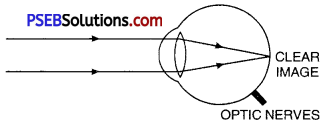
Figure (a) Normal eye. Far point at infinity. Rays from distant object meet at retina.

Figure (b) Defective eye (eye-ball is enlarged), or focal length decreased, cannot focus rays from infinity at retina.

Defective Eye. Due to eye ball getting short or an increase in focal length of eye lens, the rays do not focus on retina.

Figure (c) Defective Eye is able to form image at the retina when object is moved from N to N’ the near point of defective eye.

Figure (d) Corrected Eye. A convex lens of suitable focal length converges the rays to match those coming from hf.
Normal eye is able to focus on retina the rays emerging out from N [Figure (a)].
However, the defective eye is not able to focus the rays from near point of normal eye i.e. N [Figure (b)].
It can focus the rays from near point of defective eye i.e., N’ [Figure (c)].
From Figure (b) and (c), we conclude that more inclined rays [Figure (6)] are not focussed on retina whereas less inclined rays from N’ get focussed on retina.
Correction of hypermetropia: This defect is corrected by placing a convex or a converging lens of suitable focal length before the eye so that the rays diverging from N after refraction, appear to come from the near point N’.
3. Presbyopia: This is an age related defect. Almost all persons above 40 years suffer from this defect. The flexibility of eye lens decreases with age and the ciliary musclles are not able to change the focal length of eye lens and the person cannot see distinctly. Because of mixed defect of myopia and hypermetropia a person needs either two spectacles one each mounted with convex lens and concave lens or a bifocal lens to correct this defect.
4. Colour Blindness: This defect is due to biological reasons. It is a genetic disorder. The patient having this defect can not distinguish colours because in retina of eye, there are insufficient number of cones. These are cells present in the eye which recognise red, blue and green colours. The person suffering from this defect cannot recognise specific colour due to insufficient cone like structures in his eye. This defect cannot be corrected. The person having this defect can see all the things but can not recognise some colours.
5. Astigmatism: The person suffering from this defect can not focus in both the horizontal and vertical axis clearly. This defect is caused due to varying curvature in lens in two axis i.e. the lens is not completely spherical. The person cannot focus in vertical direction. This defect can be corrected by wearing spectacles fitted with cylinderical lens.
![]()
Question 3.
What is prism? Explain deviation in glass prism by drawing a ray diagram.
Answer:
Prism: A portion of transparent medium bound by two plain refracting surfaces at an angle to each other is called a prism. The surfaces of the prism from which refraction occurs are called refracting surfaces and the angle between them is called angle of prism.
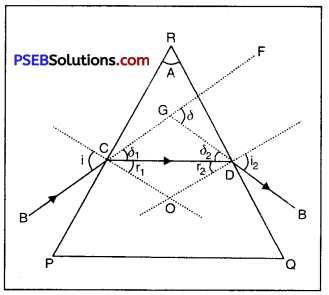
Deviation of Light by a Prism: Let PQR be the principal section of glass prism. Suppose a ray of light BC is incident at C on the surface PR of the prism. After refraction from this surface it goes bending toward normal along CD.
Now ray CD is incident at D on the refracting surface QR and after refraction it goes away from the normal drawn at D emerging along the direction DE. Therefore, prism deviates the ray of light coming along BC into direction DE. In this way prism produces angular deviation in the direction of light. If incident ray BC is produced in the forward direction and emergent ray DE in the backward direction, then they meet each other at G. The LFGD formed between these two is called angle of deviation. It is denoted by δ (delta).
The value of angle of deviation depends on (i) the material of the prism and (ii) angle of incidence. If we increase the value of angle of incidence (∠i) then the value of angle of deviation (δ) decreases. For a certain value of angle of incidence, the angle of deviation becomes minimum. This minimum value of angle of deviation is called minimum angle of deviation. If for a prism, A is the angle of prism and δm is the minimum angle of deviation, then, refractive index of material of the prism, μ = \(\frac{\sin \left(\frac{\mathrm{A}+\delta_{m}}{2}\right)}{\sin \frac{\mathrm{A}}{2}}\)
Question 4.
What is meant by dispersion of light. Explain with the help of diagram and give the cause of dispersion.
Or
When a ray of light passes through a glass prism then a spectrum is obtained on the screen.
(а) Draw a diagram showing a spectrum of white light.
(b) Name the seven colours of spectrum in a serial order.
(c) Which colour of the spectrum suffers most deviation and which colour the least deviation?
Answer:
Dispersion of Light: The process of splitting of white light into its seven constituent colours is called dispersion or dispersion of light.
(а) Spectrum obtained by Dispersion through Prism. When a ray of white light coming from the sun passes through a prism then due to refraction it deviates from its path and bends towards the base of the prism and splits into its seven constituent colours and each light colour bends through a different angle forming a band of seven colours called spectrum.
(b) Generally we see the seven colours of specturm as a group. The order of seven colurs of spectrum are in the following order starting from the base of prism Violet, Indigo, Blue, Green, Yellow, Orange and Red. This order of colours can be easily remembered by a word “VIBGYOR.”
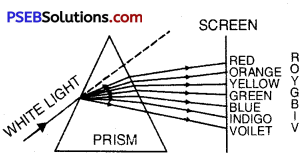
(c) The spectrum has red colour at its one end and violet colour at the other end. Red light travelling the fastest bends the least and violet light travelling the slowest bends the maximum.
Cause of Dispersion of Light: The refractive index of material (say transparent medium glass) depends on the colour of light. Refractive index of light of red colour is minimum and light of violet colour is maximum.
White light is composed of seven different colours of light (VIBGYOR) each colour having different colour due to different wavelength. Red colour has the longest wavelength and the violet has the shortest. The frequency of light is the same for colours. In air or vacuum, the speed of light is same for all colours. But in different media, the speed of light is different for different colours. So each light bends by different angle. Red colour in any medium bends the least while violet colour bends the most. So when light is passed through glass prism each light colour bends through different angle forming spectrum.
In this way, on passing of white light through a glass prism dispersion of light occurs.
Dispersion of white light does not takes place when it passes through a glass slab because there does not take place deviation of rays of light but lateral displacement occurs. The incident ray and emergent ray become parallel in glass slab.
Question 5.
Describe an experiment to show that different colours of white light can be recombined to form white light.
Answer:
To show that colours are not produced by the prism but are present in white light itself and the prism only separates these colours, Newton isolated a particular colour say green. He placed another prism in the path of green beam. No further splitting of colour took place. The light only deviated further. It clearly showed the prism just separates, a large number of colours coming together as white [Figure (b)].
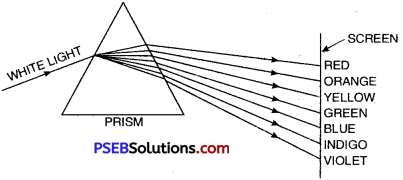
Figure (a) Dispersion of white light by a prism.

Figure (b) Second pris,iz unable to split green bewn.

Figure (c) If a similar inverted second prism is placed. seven colours recombine spectrum colours into white light.
If a second prism of exactly of same angle with its refract ing edge opposite to the first is placed as shown, it is found that it results in white light again [Figure (c)]. The second prism deviates the rays in opposite direction. Thus dispersion produced by one prism is cancelled by the second similar prirn placed in the opposite direction.
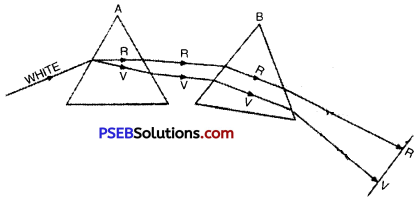
Figure (d) When second prism is placed in sqnw way, the coloured beams are further spread.
If the second prism is placed in; the same way as the first, the coloured rays are again obtained on the screen but there are more spread [Figure (d)].
Short Answer Type Questions
Question 1.
What is name of defect of eyes due to loss of elasticity of eye-lens? How is it corrected?
Answer:
It is called presbyopia. It cad be corrected by using two separate spectacles one for near vision and the other for distant vision.
Question 2.
What is the function of ciliary muscles in the eye?
Answer:
Ciliary muscles pull/push the lens and thereby change its focal length in order to focus objects lying at different distances from the eye.
Question 3.
What happens when elasticity of the eye lens is reduced to zero?
Answer:
Decrease of Elasticity of Lens. In normal eye, the change in the power of the eye lens for seeing far and near points is very large. As the person grows older, the power of accommodation gradually decreases. A stage may even reach when ciliary muscles lose their power and crystalline lens become much less elastic, so that the power of acommodation is almost zero.
Question 4.
Why is eye considered the best gift of God?
Answer:
It is said that world exists only if there are healthy eyes. Human being can see with the god-gifted eye i.e. he can identify different objects properly, can distinguish, i-ecognise colours and can differentiate between small and big even without touching, can read and write and can see all wonders of the world. That is why eye is considered to be one of the best gifts that god has given.
Question 5.
When we enter some dark room then for some time we are not able to see anything and remaining there for long, if suddenly strong light is switched on then our eyes can not gee anything. Why?
Answer:
Behind cornea there is iris which regulates the size of pupil. With it the intensity of light entering the eye is controlled. When we enter some dark room then for image to be formed on the retina more light is needed. For allowing more light to enter the eye is wide opened and it takes some time for this. During that time we do not see anything. Similarly while sitting itt the dark, iris spreads so that more light may enter the eye. And if suddenly strong light appears then to reduce its size some time is required during which we cannot see anything.
Question 6.
What type of lens is present in front of eyeball? What is its main function?
Answer:
In human eye the convex lens is present in front of eye ball. It consists of fibrous jelly like substance. Its curvature is controlled by ciliary muscles. The most of light rays are refracted by cornea and aqueous humour. The crystalline lens ensures focal length. So that the image of the object may be formed on the retina.
Question 7.
What is the function of retina in human eye?
Answer:
When light falls on rejina, it excites rods and cones. The electric pulses produced are conveyed to brain through optic nerve.
Question 8.
Why do we experience difficulty when we read from too close?
Answer:
Because of its capacity and properties the eye lens can change its focal length to some limit but not below that. If any object is too close then the focal length of the eyelens does not change that much that it niay help in seeing that properly. Therefore, we experience difficulty in reading from a close distance. In doing so pressure is exerted on eye and we cannot see distinctly.
Question 9.
Why do aged persons need spectacles for reading?
Answer:
Approximately at the age of 60 years the near point of eye becomes 20 cm which was 25 cm for normal eye of a young person. Due to this the aged person faces difficulty while reading and, therefore, needs spectacles.
![]()
Question 10.
What is cataract? How is it corrected?
Answer:
Sometimes, the crystalline lens of aged person gets covered with a membrane which obstructs the passage of light rays through a transparent lens. At times the lens becomes completely opaque or cloudy. This condition is called cataract. This defect can be corrected either by using contact lens of suitable focal length or by surgery.
Question 11.
What is the necessity of eye donation? Explain.
Answer:
We know eye is the wonderful and priceless gift of God and 65% of people in the world are blind of which 45 lakh suffer with corneal blindness. They can be cured only by cornea transplantation. Therefore, after death we and our kins should donate eyes so that others who have become blind due to corneal defect may also see the world.
Question 12.
What things we should take into account while donating eyes?
Answer:
- After death eyes must be removed within 4 to 6 hours.
- The nearest eye bank should be informed immediately after death. The team of the eye bank removes eyes of the dead person either at his residence or in the nearest hospital in 10-15 minutes.
- Eye removal is a simple procedure and does not lead to any disfigurement.
Question 13.
What is meant by least distance of distinct vision?
Answer:
Least Distance of Distinct Vision. If an object is very close to the eye then it is not seen clearly. Therefore, that shortest distance where if an object placed is seen very distinctly is called the least distance of distinct vision. For normal eye this distance is 25 cm.
Question 14.
A 14 years old boy cannot read question written on the black-board lying 5 m away from him.
(i) Name the eye defect he is suffering from.
Answer:
He is suffering from Myopia.
(ii) Show with the help of a labelled diagram as to how this defect can be corrected.
Answer:
For correction of this defect a concave lens of suitable focal length is used.
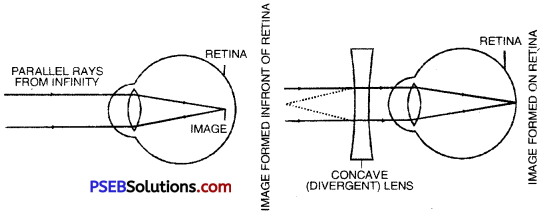
Figure (a) Myopic Eye (b) Correction of Myopia by a concave lens of suitable focal length.
Question 15.
Why we see a rainbow just after rains?
Answer:
Rainbow is caused by dispersion of white sun light by tiny water droplets present in the atmosphere. Water droplets act as tiny prisms. They refract and disperse the incident sunlight, then reflect it internally and finally refract it again when it comes out of raindrop. Due to dispersion of light and internal refraction, different colours reach the eye of the observer. Rainbow is always formed in a direction opposite to that of the sun.
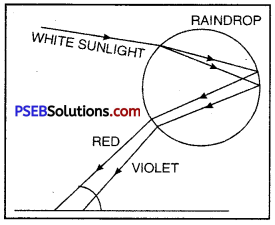
Rainbow formation
Question 16.
How refraction of light elongates the length of day?
Or
Why does day appear longer than actually what it is due to refraction of light?
Answer:
The sun is visible a few minutes earlier than it actually rises above horizon. It happens because as we go up from the earth, the density of air layers decrease. The rays from sun S keep on bending towards normal till it enters the eye. Therefore, the sun appears to be at S’ (above horizon) although it is at S (below horizon). Thus the sun appears about two minutes earlier than actually when it should be.
For the same reason, the sun appears to set two minutes later than the actual. Hence the day appears to be about 4 minutes longer than what it is.
For the same reason explained above, the stars appear higher than their actual position as shown in Figure (b) given below :
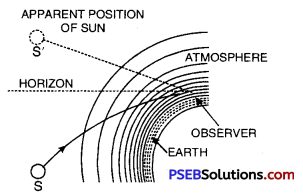
Figure (a) The sun remains visible even after it has actually passed below the geometrical horizon.
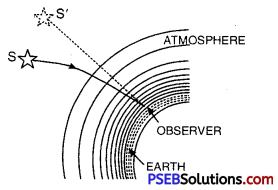
Figure (b) A star in the direction S is seen in the direction S’ as a result of atmospheric refraction.
Question 17.
A star appears on the horizon. What is the true position of the star? Explain with diagram.
Answer:
True position of star is below the horizon. Incident rays from star, travel through earth’s atmosphere and reach observer’s eye. These incident rays travel from rarer to denser atmopshere so that they bend towards the normal. Thus, they appear to come fiom a different position slightly higher than the true position.
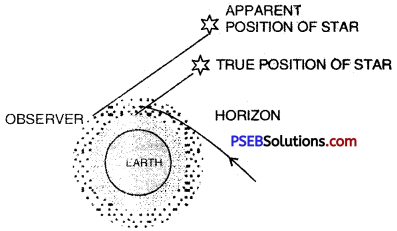
Question 18.
What is meant by scattering of light? Explain Tyndall effect. Give a few illustrations of scattering of light.
Answer:
The path of beam of- light becomes visible when it passes through space containing smoke, tiny water droplets, suspended dust particles. The path of light is visible when it pass through ak medium the size of whose particles are comparable to wavelength of light.
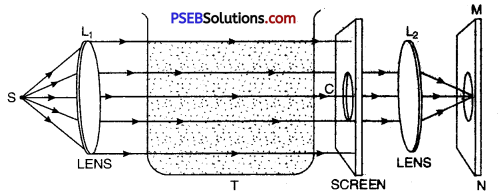
An arrangement for observing scattering of light in colloidal solution Colour of scattered light depends upon the size of scattering particles. Very small particles scatter blue light while larger particles scatter light of longer wavelength.
Question 19.
Why does the colour of the sky appear blue? [P.B., March 2019 (Set-A)\ Also tell how it would appear in the absence of earth’s atmosphere?
Answer:
The molecules of air/gases and other fine particles in the atmosphere have smaller size than the wavelength of visible light. These particles are therefore, more effective in scattering light of shorter wavelengths at blue and than light of longer wavelength at the red end. Thus, blue colour of the sky is due to scattering of sunlight by fine particles. In the absence of earth s atmosphere no scattering of light can occur. So, the sky appears black in that case.
Question 20.
What is short-sightedness? For a person suffering from this defect, where is the image of an object formed and by what type of spectacles this defect can be corrected?
Or
What is the cause of Myopia? How can it be corrected? Explain with a labelled diagram. (P.S.E.B. March 2017, Set-I)
Answer:
Myopia or Short Sightedness: A person with myopic eye can see the near objects clearly but cannot see far off objects. The person suffering from myopia or short-sightedness has far point nearer than infinity. In normal eye, the far point is at infinity. The rays coming from distant object (at infinity) get focussed on retina [Fig. 11.5 (a)].
Causes of Defect: The defect myopia arises due to either :
- the length of eyeball is elongated (becomes longer than normal)
- the focal length of eye lens has decreased.
Due to either or both the causes, the eye is not able to focus the rays from distant object at retina [Figure (d)]. Focussing is there at a point 0 in front of retina. Therefore, the image formed on retina is blurred.
The defective eye is however able to focus the object upto its far point [Figure (c)].

Figure (a) Normal eye. Far point at infinity. Rays from distant object meet at retina.

Figure (b) Defective eye (eye-ball is enlarged), or focal length decreased, cannot focus rays from infinity at retina.

Defective Eye. Due to eye ball getting short or an increase in focal length of eye lens, the rays do not focus on retina.

Figure (c) Defective Eye is able to form image at the retina when object is moved from N to N’ the near point of defective eye.

Figure (d) Corrected Eye. A convex lens of suitable focal length converges the rays to match those coming from hf.
Normal eye is able to focus on retina the rays emerging out from N [Figure (a)].
However, the defective eye is not able to focus the rays from near point of normal eye i.e. N [Figure (b)].
It can focus the rays from near point of defective eye i.e., N’ [Figure (c)].
From Figure (b) and (c), we conclude that more inclined rays [Figure (6)] are not focussed on retina whereas less inclined rays from N’ get focussed on retina.
Question 21.
What is the cause of long sightedness (Hypermetropia)? How can it be corrected? Explain with a labelled diagram?
Answer:
Correction of hypermetropia: This defect is corrected by placing a convex or a converging lens of suitable focal length before the eye so that the rays diverging from N after refraction, appear to come from the near point N’.
Question 22.
What is meant by Presbyopia and Colour blindness?
Answer:
Presbyopia. Some people suffer from myopia and hypermetropia both simultaneously, it is called presbyopia. Such people require bifocal lenses, the upper part of which is concave lens and the lower part a convex lens. The upper part is used to see distant objects while the lower part to see nearby objects (for reading).
Colour Blindness: This defect is caused due to decrease of cone like cells in the eyes of human beings. Due to this loss, eye is not sensitive for some particular colours. This is genetic defect and has no remedy. The persons having this defect can no doubt see objects but are unable to identify colours. This is called colour blindness.
![]()
Question 23.
Define the following :
Power of Accomodation, Far Point, Near Point, Least Distance of Distinct Vision, Persistence of Vision.
Answer:
Power of Accomodation Human ejre can see all nearby objects and distant objects. This ability of eyelens to adjust its focal length enabling it to see object lying at different distances is called power of accomodation.
Far Point. The point at the maximum distance from the eye where if an object is placed can be seen distinctly is called far point. For normal eye the far point is at infinity.
Near Point: The point at the leat distance from the eye where the object if lying can be seen distinctly is called near point.
Least Distance of Distinct Vision. It is a point in between the far point and near point and at minimum distance from eye where the object lying can be seen distinctly. For normal eye the least distance of distinct vision is 25 cm.
Persistence of Vision. The image of an object is formed on the retina of the eye but even if the object is removed still its image remains and does not fade away. This is called persistence of vision.
Question 24.
A person wears spectacles of power – 2.5 D. Name the defect of vision he is suffering from. Draw the ray diagram for (i) the defective eye, (ii) its correction after using a suitable lens.
Answer:
Since the power of the lens is negative, therefore, the lens used in spectacles is concave lens.
The defect of the eye is Myopia (or short sightedness)

Figure (a) Defective eye (eye-ball is enlarged), or focal length decrea.’ed, cannot focus rays from infinity at focus.

Figure (b) Corrected eye. Concate (or a divergent) lens diverges the parallel rays from infinity to an extent that they appear to diverge from F. They get focussed at retina.
Question 25.
Distinguish between simple microscope and compound miéroscope.
Answer:
Differences between Simple Microscope and Compound Microscope.
| Simple Microscope | Compound Microscope |
| 1. It is convex lens of small focal length. | 1. It has two convex lenses one of which is eye piece and other objective. |
| 2. It has small magnification. | 2. Its magnifying power ìs large. |
| 3. It is used to see small objects after magnification. | 3. It is used to see very minute objects which cannot be otherwise seen with a naked eye after very large magnification. |
Numerical Problems
Question 1.
A person can not see clearly objects beyond a distance of 1.2 m. Name the defect of vision he is suffering from. What would be the power of correcting lens used to restore proper vision ?
Answer:
Since a person can see clearly only near objects (upto a distance of 1.2 m only) whereas normal human eye can see even distant objects (upto infinity), therefore, the defect of vision is myopia.
Here v = 1.2 m
u = ∞
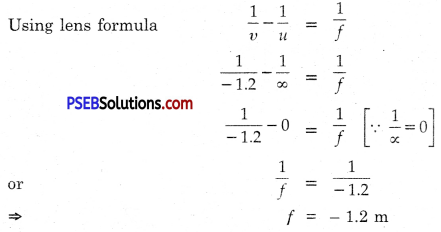
∴ Power of correcting lens, P = \(\frac{1}{f(\text { in metres })}\)
= \(\frac{1}{-1.2}\)
= – 0.83 D
Question 2.
The near point of a person suffering from hypermetropia is 75 cm. Calculate the focal length and power of the lens required to enable him to read the newspaper which is kept at 25 cm from the eye.
Answer:
Here u = -25 cm
v = – 75 cm

∴ Focal length of the required lens
Now P = \(\frac{1}{f(\text { in metres })}\)
= \(\frac{1}{375}{\frac{1000}}\)
= \(\frac{1000}{375}\)
= 2.6 D
Question 3.
The near point of a myopic eye is 1 m. Find the power of the lens required to correct this defect. Assume that near point of the normal eye is 25 cm.
Answer:
Here u = – 25 cm [Normal near point]
V = – 1 m
= – 100 cm
f =?
Using lens Formula \(\frac{1}{v}-\frac{1}{u}=\frac{1}{f}\)
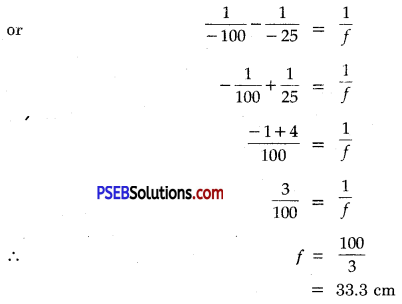
Now power of the required lens P = \(\frac{1}{f(\text { in metres })}\)
= \(\frac{100}{f(\text { in metres })}\)
= \(\frac{1}{\frac{100}{3}}\)
= \(\frac{100 \times 3}{100}\)
= + 3 D
Positive sign (+) indicates that the lens is convex.
Question 4.
A person cannot see objects beyond 1.5 m distinctly. What type of lens should be used to restore proper vision?
Answer:
Here u = – ∞ ; u = -1.5 m ; f =?
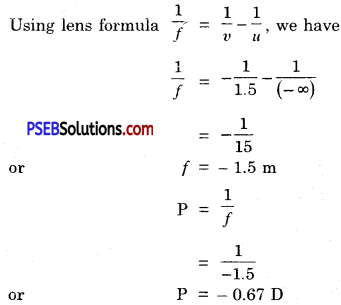
He should use concave or divergent lens say convexo concave lens of Focal length -1.5 m and power – 0.67 D.
Very Short Answer Type Questions
Question 1.
What do you mean by optical instruments? Name any two.
Answer:
Optical instruments are the devices based on various phenomena of optics. The’names are (i) Microscope (ii) Telescope.
Question 2.
What is least distance of distinct vision?
Answer:
Distance upto which a person can see clearly. It is 25 cm for normal eye.
Question 3.
What is far of point?
Answer:
This is most distant point upto which the eye can see clearly with unaided eyes.
Question 4.
Write a function of each of :
(i) Retina
Answer:
Retina: Retina is third layer of eye and acts as a screen for the image of the objects.
(ii) Sclerotic
Answer:
Sclerotic: Sclerotic is to maintain a solid shape of the eye and protects the internal soft parts from external injuries.
(iii) Ciliary muscles in human eye.
Answer:
Ciliary muscles in human eye. Eye lens is held in its position by ciliary muscles. Ciliary muscles help the eye to change the focal length by adjusting its curvature.
![]()
Question 5.
What is the function of sclerotic in human eye?
Answer:
Sclerotic is to provide a solid shape to eye and protect it from external injuries.
Question 6.
What is the function of ciliary muscles in human eye?
Answer:
Ciliary muscles help the eye to change its focal length by adjusting its curvature.
Question 7.
What is the function of rods on the retina?
Answer:
Rods are sensitive to light. More the intensity of light, more are they excited.
Question 8.
What are cones?
Answer:
Cones on retina are sensitive to different colours. If cones are absent or insufficient, the person is colour blind.
Question 9.
Why chickens come out late in the morning and return early in the evening?
Answer:
Chickens have very few rods on the retina, hence they are able to see only in bright light and not in dim-light.
Question 10.
Why cats / bats are able to see at night?
Answer:
They have very large number of rods on retina. Hence they are able to see even if there is very small amount of light.
Question 11.
Colour of eyes depend upon colour of which part of eye?
Answer:
It depends upon the colour of iris.
Question 12.
What is basic cause of colour blindness?
Answer:
It is due to no or insufficient number of cones on the retina.
Seeing sun or seeing towards it during solar eclipse may cause colour blindness.
Question 13.
Which phenomenon of light is shown in fig. below :
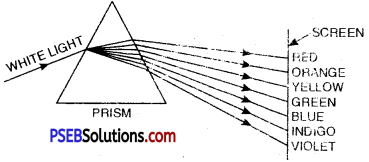
Answer:
Dispersion of light.
Question 14.
In the given diagram which defect of the human eye is being corrected using a concave lens?

Answer:
Myopia (Short-Sightedness).
Question 15.
Which defect of human eye is being corrected in the figure given below?

Answer:
Hypermetropia.
Question 16.
Which defect of the eye is shown in the figure given below?

Answer:
Hypermetropia (or Long-sightedness).
Multiple Choice Questions :
Question 1.
The approximate least distance of distinct vision of normal eye is
(A) 35 in
(3) 3.5 m
(C) 25 cm
(D) 2.5 cm.
Answer:
(C) 25 cm
Question 2.
The feal length of objective is changed by:
(A) Pupil
(B) Retina
(C) Ciliary muscles
(D) Iris.
Answer:
(C) Ciliary muscles
Question 3.
A person suffering from short sightedness cannot see objects beyond 1.2 m. For distinct vision he would use :
(A) Concave lens
(B) Cylinderical lens
(C) Convex lens
(D) None of these.
Answer:
(A) Concave tens
Question 4.
The far point of normal human eyes .
(A) At 25 cm
(B) At 25 mm
(C) At 25 m
(D) At infinity.
Answer:
(D) At. infinity.
![]()
Question 5.
In human eye, the image of object is formed at:
(A) Pupil
(B) Retina
(C) Cornea
(D) Eye ball.
Answer:
(B) Retina
Question 6.
Light entering the eye is mostly refracted by :
(A) Crystalline lens
(B) Outer surface of cornea
(C) Pupil
(D) Iri’.
Answer:
(B) Outer surfaceof cornea
Question 7.
Most insensitive part nf the eye is called:
(A) biqek spt
(B) vehow spot
(C) cornea
(D) blue Spot.
Answer:
(A) black spot
Question 8.
Focal length of the eye lens can be adjusted by action of:
(A) ciliarv muscles
(B) choroid
(C) optical nerves
(D) retina.
Answer:
(A) ciliary muscles
Question 9.
When light rays enter the eye most of the refraction occurs at:
(A) crystalline lens
(B) iris
(C) outer surface of cornea
(D) pupil.
Answer:
(A) crystalline lens
Question 10.
Distance of distinct vision of a normal eye is:
(A 25 m
(B) 2.5 m
(C) 25 cm
(D) 2.5 cm.
Answer:
(C) 25 cm
Question 11.
Accommodation of normal eyes is
(A) 5 cm to 15 cm
(B) 15 cm to m
(C) 1 m to 3 m
(D) 20 cm to infinity.
Answer:
(D) 20 cm to infinity.
Question 12.
When an object is placed beyond centre of curvature of a cancave mirror, the image is formed:
(A) beyond C;
(B) between C and F;
(C) at F;
(D) at infinity.
Answer:
(B) between C and F;
Fill in the blanks:
Question 1.
The least distance of distinct vision is __________
Answer:
25 cm.
Question 2.
Far point of normal human eye is __________
Answer:
infinity.
Question 3.
In human eye, image of an object is formed at __________
Answer:
Retina.
Question 4.
The ability of eye-lens to adjust its focal length is called __________
Answer:
Accommodation.
![]()
Question 5.
A shortsighted person cannot see the objects distinctly.
Answer:
distant.
Question 6.
The __________ shaped cells present in retina respond to the intensity of light.
Answer:
rod.
Question 7.
__________ helps in regulating the amount of light entering the eye.
Answer:
pupil.
Question 8.
The splitting of white light into its component colours is called __________
Answer:
dispersion.
Question 9.
A concave lens is used to rectify __________
Answer:
Myopia.
Question 10.
When the light is bright, the pupil becomes __________
Answer:
very small.